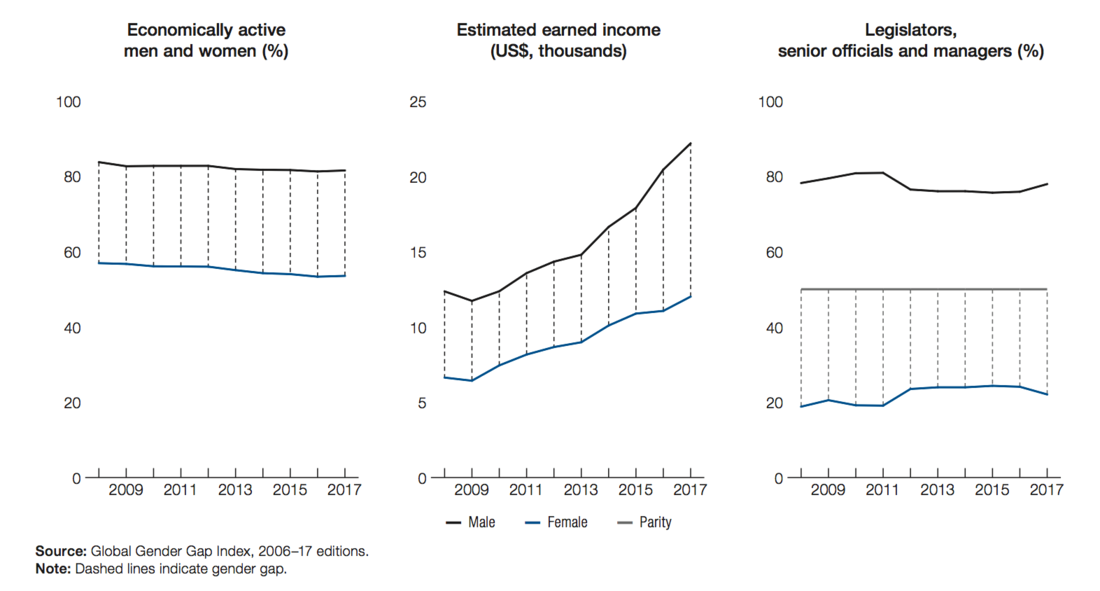男女收入差距仍在扩大,实现两性职场平等需要217年
|
最近一系列性骚扰指控的矛头都直指位高权重的男士。如果说指控有什么含义,应该就是女性在争取职场平等待遇方面征途漫漫。本周四,世界经济论坛(WEF)预测了一个问题解决的具体时限。各位女士,你们还得奋斗217年。 WEF新近发布的《2017年全球性别差距报告》考虑到了多方面因素,将女性的经济活动参与度和机会、受教育程度、健康和生存状况、政治赋权与男性对比。报告发现,在报告发布以来覆盖的106个国家中,如果要在以上四方面都实现男女平等需要整整一百年,比去年该报告的预估时间长了十七年。 如果只考虑经济层面,女性要赶上男性还需要更久,得花217年。这是因为,考虑劳动力参与率、薪资差距和在专业领域的领导地位,女性在经济方面的性别差距非但没有缩小,反而还在扩大。事实上,在2013年达到史上巅峰之后再无进展,一直在退步,今年已退回2008年的水平。 WEF认为,虽然没有国家能彻底消除经济方面的性别差距,但有13个国家已经基本实现男女平等,将差距缩小了80%左右。以经济的指标衡量,非洲小国布隆迪的表现最佳,性别差距减少了91%。巴巴多斯、巴哈马、贝宁分列第二到第四位,其男女国民在经济方面的差距分别缩小了88%、87%和86%。美国排名第19位,差距收窄了78%。 从均值看,2017年榜单中各国在经济方面的男女差距缩小了58%,之前的2015年和2016年差距均为59%。 对于女性在经济方面的不利地位为何进一步恶化,WEF的报告提供了一些线索。虽然全球男性和女性的劳动力参与率都在下降,但女性的降幅特别大。同时,虽然两性的收入都有增加,但男性涨得更多。报告指出:“这意味着,经济繁荣并没有平等地惠及男性和女性。”而且,女性在公共部门和企业界的高层仍没有足够的地位:今年女性高层管理者人数只占22%。 |
If the recent string of sexual harassment allegations against high-powered men is any indication, women have a long way to go before achieving equal treatment in the workplace. On Thursday, the World Economic Forum pegged a specific time frame to solving the problem, and ladies, it’s going to be a slog: 217 years. The new WEF report on the global gender gap takes into account women’s economic participation and opportunity, educational attainment, health and survival, and political empowerment as compared to men’s. It found that it’ll take exactly 100 years to close the gap across all four factors in the 106 nations included in the report since its inception—17 years longer than last year’s estimate. But taking into account only women’s economic deficiency, it’ll take even longer—217 years. That’s because rather than shrinking, the economic gender gap—which considers women’s labor force participation, wage equality, and professional leadership—continues to widen. In fact, progress on this front reverted back to its 2008 level this year, after peaking in 2013. Not a single country has fully closed its economic gender gap, though 13 have come close, narrowing it 80% or more, according to WEF. The small African nation of Burundi is the top performer by this measure, having closed 91% of its economic gender gap. Barbados, the Bahamas, and Benin are second (88%), third (87%), and fourth (86%) respectively. By comparison, the U.S. is ranked 19th, having narrowed its gap 78%. On average, nations had closed 58% of their economic gender gaps in 2017, down from 59% in both 2016 and 2015. The report offers a few clues as to why the women’s economic disadvantage is getting worse. While global labor force participation is declining for both men and women, the dip has been especially steep for women. At the same time, earned income is on the rise for both sexes, but it’s been especially sharp for men, “suggesting that the growth in prosperity is not equitably distributed along gender lines,” the report says. Plus, women remain underrepresented in senior positions in the public sector and in business: This year, women accounted for just 22% of senior managerial positions. |

|
为了进一步推动男女平等,报告谋划出鼓舞人心的美好蓝图:而且会产生巨大的经济效益。如果能在2025年以前消除经济活动参与度方面的男女差距,全球GDP可能增加约5.3万亿美元。只要在经济方面实现男女平等,单单美国的GDP就可能增加1.75万亿美元。报告认为,这些数字意味着,“假如公共部门增加投入消除全球性别差距,该项目很可能实现自给自足。” (财富中文网) 译者:Pessy 审校:夏林 |
The report provides a major incentive to increase efforts on the gender equality front: There’s a ton of money on the line. Closing the economic participation gender gap 25% by 2025 could add some $5.3 trillion to the world GDP. The U.S. alone could see an extra $1.75 trillion by achieving economic gender parity. Those figures, the report says, suggest “the potential self-financing effects of additional public investment into closing global gender gaps.” |













